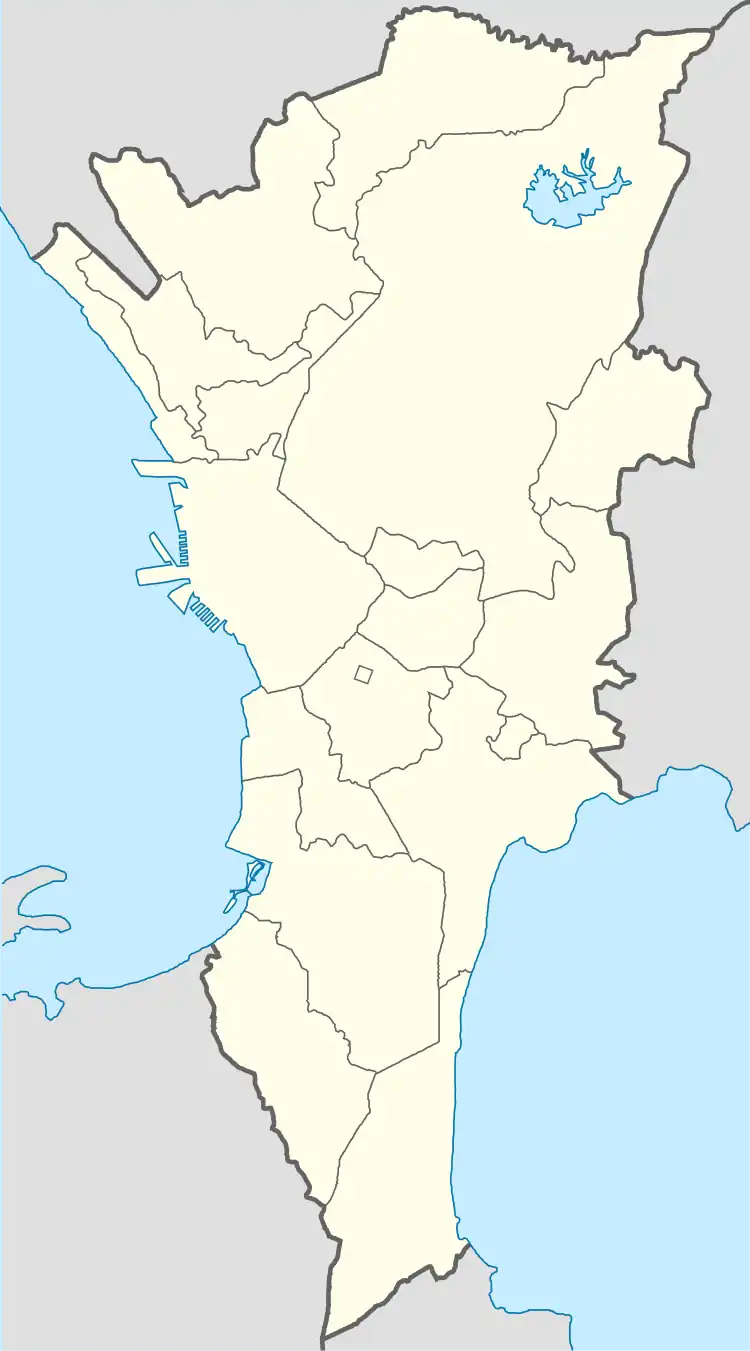Baclaran
Bacladan (archaic) | |
|---|---|
.jpg.webp) Karakol celebration on Roxas Boulevard in Baclaran, May 2019 | |
 Baclaran | |
| Coordinates: 14°31′55″N 120°59′39″E / 14.53194°N 120.99417°E | |
| Country | Philippines |
| Region | National Capital Region |
| City | Parañaque |
| District | 1st Legislative District of Parañaque |
| Established | 1971 |
| Government | |
| • Type | Barangay |
| • Barangay Captain | Julius Anthony Zaide |
| • Sangguniang Barangay | Kagawad |
| Area | |
| • Total | 0.6372 km2 (0.2460 sq mi) |
| Population (2020) | |
| • Total | 33,850 |
| • Density | 53,000/km2 (140,000/sq mi) |
| Time zone | UTC+8 (PST) |
| Postal Code | 1702 |
| Area code | 02 |
Baclaran is a barangay located in the northern area of the city of Parañaque, Metro Manila, Philippines. It is also known to be located at the borders of the cities of Parañaque and Pasay.
Because of its proximity to the shore of Manila Bay, the place was named after a piece of fishing equipment called "baklad". Baklad is a rattan fence placed around the fish to protect them until they are ready to be sold in the market. Many of these baklads were assembled at the seashore, so people started calling the place "Bakladan". The Filipino grammatical feature of changing d's to r's when a suffix is added changed this to "Baclaran".
History
Then a barrio, Baclaran was excised, alongside barrio Tambo, from the then-municipality of Parañaque to form part of the newly established municipality of Baclaran in 1965, when both municipalities were part of Rizal province.[1] However, the Supreme Court of the Philippines later voided the creation of the new municipality, thus returning the aforementioned barrios to Parañaque.[2]
Baclaran was established in 1971 in the municipality, now city, of Parañaque.[3] It was later converted into a barangay alongside all other barrios in the Philippines in 1974.[4]
In 1973, Cardinal Karol Józef Wojtyła (later Pope John Paul II), then the Archbishop of Kraków, visited the Baclaran Church and celebrated Mass there during a brief, unofficial stopover in Manila, which was his first visit to the Philippines. In 1981, Wojtyła as Pope John Paul II returned to the shrine as part of his apostolic visit to the Philippines.
The area is well known for the National Shrine of Our Mother of Perpetual Help, also known as the Redemptorist Church or Baclaran Church, dedicated to Our Mother of Perpetual Help. The first Wednesday of every month is dedicated to the shrine of Our Lady of Perpetual Help.[5] There was also once Muslim mosque, the Baclaran Mosque, now demolished by the City of Pasay. Baclaran is known for its children and youth membership in the local rondalla, which won at NAMCYA in 1996, and the Drum and Lyre Band, as well as its street welding. There are a number of tiangges (flea markets) occupying the westbound lane of Taft Avenue.
Transportation
Located near the intersection of Epifanio de los Santos Avenue and Roxas Boulevard, Baclaran is a major transportation hub and transfer point. The Baclaran station, the southern terminal station of the Manila Light Rail Transit System Line 1 located in Pasay, serves the barangay. Line 1 Extension is currently under construction to extend the line southwards to Cavite, with Redemptorist station being built in the barangay. Many bus and jeepney routes pass through Baclaran or have it as their end destination, especially transportation to and from the province of Cavite to the south. Baclaran also has the closest street near the four terminals of Ninoy Aquino International Airport, more known as the Airport Road. Wednesdays are generally busier as novena devotees come to pray at the Baclaran Church.
Cycle rickshaws can also be used to navigate the interior streets.
References
- ↑ Executive Order No. 213, s. 1965 (December 3, 1965), Creating the Municipality of Baclaran in the Province of Rizal, retrieved April 2, 2023
- ↑ Baybay, Dulce Festin; Marquez-De Guzman, Ariel (2001). Palanyag to Parañaque: A History. City of Parañaque, 2001. Retrieved April 2, 2023.
- ↑ Febriana, Baiq Anita; Purwoko, Agus Abhi; Andayani, Yayuk (2017). "Problem-based Learning in Senior High School Chemistry and Its Impact on Critical Thinking Skills of Different Dispositions Students". 2nd Asian Education Symposium. Scitepress - Science and Technology Publications: 80–85. doi:10.5220/0007299000800085. ISBN 978-989-758-331-5.
- ↑ Presidential Decree No. 557, s. 1974 (September 21, 1974), Declaring All Barrios in the Philippines as Barangays, and for Other Purposes, Official Gazette of the Republic of the Philippines, retrieved October 20, 2023
- ↑ "Swinburne, John, (born 4 July 1930), Founder and Leader, All Scotland Pensioners Party (formerly Scottish Senior Citizens Unity Party), 2003–13; Member (Scottish Senior Citizens Unity) Scotland Central, Scottish Parliament, 2003–07", Who's Who, Oxford University Press, December 1, 2007, doi:10.1093/ww/9780199540884.013.44062
- ↑ "Parañaque City (Philippines): Barangays - Population Statistics, Charts and Map". www.citypopulation.de.